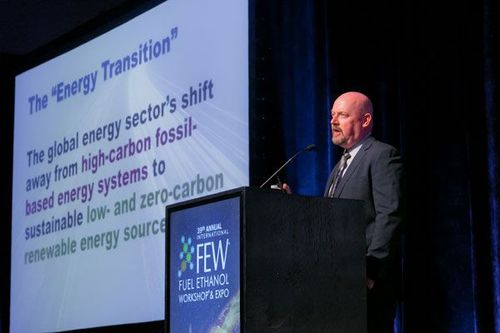Front and Center at the FEW










During his keynote, Cooper said, “Big transitions like the energy transition are hard, they’re really hard, they’re messy, they’re complex, they’re unpredictable, and that’s where government policy can play a role... / PHOTO: BBI
August 10, 2023
BY Katie Schroeder
The plenary session of the 39th annual International Fuel Ethanol Workshop & Expo, held in Omaha, Nebraska, in mid-June, was anchored by a keynote and general session panel focused on policy, market growth and ethanol’s role in a global energy transition. BBI International CEO Joe Bryan welcomed conference participants to Omaha, highlighting the industry’s commitment to community and thanking attendees for sustaining the FEW during the pandemic. “Through the pandemic, that sense of community was what allowed this conference and this industry to move forward,” Bryan said, noting that attendance at the 2023 FEW, the largest, longest-running ethanol conference in the world, reached 2,400—a fourth of which were renewable fuel producers—from 26 countries, 48 U.S. states and seven Canadian provinces.
Prior to the keynote address, awardees and scholarship recipients were announced. The recipients of the FEW Kathy Bryan Memorial Scholarship, a $2,000 scholarship awarded to high school graduates or college students with family members employed at ethanol plants, were announced by John Nelson, BBI International vice president. He also presented the 2023 FEW Award of Excellence and High Octane Award, two of the most prestigious accolades in the industry. The High Octane Award, which recognizes someone who has helped the industry progress throughout the years, was given to Mick Henderson, general manager of Commonwealth Agri-Energy in Hopkinsville, Kentucky. Henderson has worked in the industry for 42 years, improving plant systems, overseeing expansions and taking on new ventures, such as pursuing high-purity alcohol. “[Corn ethanol producers] have achieved greatness, this industry is really, really an industry to be proud of,” Henderson said. “Every one of us should be thankful for our jobs.”
The Award of Excellence, which recognizes those who have made significant contributions on a technical, research or policy front, was presented to Kelly Davis, vice president of New Energy Blue. Davis, the longtime technical director for the Renewable Fuels Association, helped many of her colleagues with her willingness to answer technical questions and solve problems over the years. Working for the industry’s best interests as a long-time appointee to the U.S. Grains Council, a member of the ASTM Committee for Petroleum Products and more, she was ready to assist members of the industry, Nelson explained. “It’s a new beginning for all the ethanol industry, and an exciting opportunity for me to be [standing] here today,” Davis said. “I can’t promise you what the future will bring, but I intend to be part of it, and I hope you will too.”
The 2023 FEW featured the first Women in Ethanol award ceremony, presented to Emily Skor, CEO of Growth Energy. Skor emphasized the importance of new perspectives and experiences being present in the ethanol industry, encouraging her fellow women in the industry to strive to be more than the “best woman” in their respective jobs, but to be the best.
The general session was kicked off with a keynote address from Geoff Cooper, president and CEO of the Renewable Fuels Association. Cooper engaged conference attendees on ethanol’s role in the “energy transition,” future market opportunities and the hazards of bad energy policy. The “energy transition,” he explained, is a term used to describe the global energy shift away from fossil-based hydrocarbons to low- and zero-carbon renewable energy sources. “When you hear ‘energy transition,’ it’s all about reducing greenhouse gas emissions and doing so as quickly as possible and in a sustainable way,” he said.
The Biden administration has announced the goal of reaching net-zero emissions by 2050, eliminating 1.8 billion tons of GHG emissions from transportation. However, Cooper explained that this transition has been accompanied by ill-conceived policy moves toward universal electrification, eliminating liquid fuels for light-duty vehicles almost entirely. This would require a mass market transition, which is a risky idea given that a transition on this scale would take a long time and be expensive. California has taken this approach by banning the sale of new internal combustion engines throughout the state by 2035, Cooper explained that this is an example of “bad policy” that arbitrarily picks technology winners and losers.
“Big transitions like the energy transition are hard, they’re really hard, they’re messy, they’re complex, they’re unpredictable, and that’s where government policy can play a role,” Cooper said. “Good policy can help bring down marketplace barriers, foster innovation, speed up technology adoption, reduce consumer costs and help mitigate those unforeseen [outcomes].”
In order to achieve a successful energy transition, Cooper said he believes it is necessary to provide an improvement to the consumer’s quality of life and livelihood. He explained that electric vehicles (EVs) currently receive zero in emissions calculations. Cooper explained that calling EVs “zero emission vehicles” is ridiculous, since it doesn’t take into account the rare minerals used in the batteries and the emissions used in electricity production. A shift to 100 percent EVs would require a 40 to 50 percent increase in electricity production and two to three thousand more power plants or large-scale clean energy generation hubs.
Proponents of an across-the-board move to electrification point out the transition from horse and buggy to motorcar as an example of how massive transitions can happen quickly. However, cars were a similar price to a horse and buggy, while also improving quality of life and solving the manure problem that many cities were facing. Cooper explained that this comparison is inaccurate because it does not take into account the fact that EVs may not improve the quality of life for every consumer the same way early motorcars did. EVs tend to be expensive vehicles that cost more to repair and insure, and they also decrease in value faster than internal combustion-powered vehicles.
The market may not be ready for the scale of a complete transition to EVs; only 1.2 percent of the current fleet is currently made up of battery or plug-in hybrid vehicles, he explained. Banning the internal combustion engine is the wrong way to jumpstart an energy transition, Cooper said. It is important that the transition is market based instead of mandate based.
“Rather than trying to force prescriptive technologies onto a market that may not be ready for them, energy transition policy should adopt a technology neutral approach that embraces the diverse portfolio of low-carbon transportation options,” he said. “Policy makers should set stable, predictable, long-term carbon reduction targets, create a level playing field by removing barriers that prevent competition, then let the marketplace do what the marketplace does. Let the market go to work, let the market solve its problem.”
Pursuing a technology neutral approach would encourage technology innovation while empowering consumers to find the best fit for their needs. As a low-cost, low carbon solution, ethanol would thrive in a truly technology-neutral environment and help “kickstart the energy transition.”
Cooper covered the positive policy advancements for the ethanol industry, including progress on the E15 front, the reintroduction of the Next Generation Fuels Act, constructive dialogue with the federal government on implementing the Inflation Reduction Act, and the continuation of the RFS program under the EPA. Bills legalizing E15 year-round have received bipartisan support, as well as the support of some large oil companies due to negotiations between RFA and the American Petroleum Institute. RFA and other allies are also advocating to make sure that the IRA is implemented in the way Congress intended, he explained. The act offers a clean fuel production credit of up to $1 per gallon, an SAF credit of $1.25 to $1.75 per gallon, an expanded CCUS credit of $60 per metric ton for CCU and $85 per metric ton of sequestered CO2. It also grants $500 million for higher biofuel blend infrastructure and $20 billion in ag conservation and carbon programs. “In my view, this policy marks the most significant federal amendment to low-carbon biofuels since the RFS was expanded in 2007,” Cooper said. “And one of the most exciting provisions in the Inflation Reduction Act for ethanol producers is the clean fuel production credit.”
The ethanol industry’s pursuit of net zero by 2050 is already yielding significant carbon reduction benefits. Currently, ethanol offers a 44 to 52 percent reduction compared to gasoline, between 2025 and 2030, this reduction is expected to average 70 percent, Cooper said. Today, an FFV running on E15 provides comparable carbon reduction to an electric vehicle. In the future, the carbon reduction benefits could be even better. RFA demonstrated carbon reductions that are possible through its hybrid FFV designed to run on E85 and electricity that comes with a 430-mile range. Cooper explained that this vehicle demonstrates a potential opportunity for consumers to buy a zero-emissions vehicle that doesn’t break the bank.
Advertisement
Advertisement
Policy Discussion
The industry association panel, including Chris Bliley, senior vice president of regulatory affairs with Growth Energy; Brian Jennings, CEO of the American Coalition for Ethanol; Troy Bredenkamp, senior vice president of regulatory affairs with the Renewable Fuels Association; and moderated by Tim Portz, BBI International program developer, discussed a variety of topics including the importance of modeling that accurately reflects the carbon intensity of ethanol, promising policies and increased blend rates.
The panel discussed the Next Generation Fuels Act, which Jennings called “a more intelligent way to tackle the energy transition.” The act would implement a higher octane rating requirement for vehicles, starting at 95 RON in 2028, increasing up to 98 RON by 2032, with a requirement that the octane enhancing agent must provide a 40 percent reduction in GHG emissions compared to gasoline. Bredenkamp explained that the act’s high octane requirements would cause OEM’s to harden new vehicle engines up to the point that they can handle E85. At the moment, the associations are doing the “shoe leather” work to lay the groundwork needed to move the bill forward.
“It’s a really good policy, [and] we do need to build more support for it,” Jennings said. “We need more co-sponsors in Congress, so that’s something that you can do at your facilities when [you're planning to] talk to your members of Congress.”
Bredenkamp said he believes the bill has an opportunity given the amount of discussion around an energy transition. “I think there is a necessity that’s coming sooner than we know, where a Next Generation Fuels Act might be coupled with a clean fuels standard concept, that type of major legislation will have opportunity, and I think it may come sooner than we think,” he said.
Importance of Modeling
A major topic for the panel was the importance of accurate modeling and how it impacts the markets available to the ethanol industry. “We all feel very confident about the future of corn-based ethanol, where it’s headed, we think it’s headed to zero, we think it could be a carbon negative [option], whether that’s in a gas tank or as a feedstock or some other use,” Bredenkamp said. “None of that happens if we don’t get this modeling right. We absolutely have to stand on a hill and make sure that the modeling is correct, because without it we don’t really have the opportunity to participate in any of the burgeoning markets like SAF, like biorefining.”
Jennings explained that modeling is key to determining the impact the Inflation Reduction Act has on ethanol’s potential as a feedstock for SAF within the alcohol-to-jet production process. While most of the tax credits within the IRA use GREET as the model for determining the carbon intensity of the renewable fuel, the SAF portion of the act uses a model developed by the International Civil Aviation Organization (ICAO). Right now, ICAO’s model lists corn-based ethanol with a carbon intensity number of 91, which is an obstacle to accessing the real potential of the tax credit, Bredenkamp said. The panelists said it is vital that the GREET model is adopted as the Treasury Department determines the implementation of the Inflation Reduction Act. Jennings called it the “gold standard” for modeling because of how frequently it is updated, and Bliley agreed, saying it is “a true, accurate measuring stick for our industry.”
The IRA does provide a good foundation for utilization of ethanol within the SAF industry. However, taking advantage of 45Z credits may require getting tax extenders in the near future since the window for these credits opens in 2024 and ends in 2027, there is not much time for producers to implement new technologies or products needed to take advantage of these credits associated with carbon capture technologies. “We’re going to be up against some expiration dates, [so] we will all be working on a tax extender to make that program really work,” Bredenkamp said. “But I think the nuts and bolts are there to at least get this jumpstarted pretty well.”
However, GREET still has room for improvement. Jennings explained that ACE is trying to bring down the amount of carbon intensity assigned to land use impact to better reflect modern farming practices, reducing it from the current penalty of eight grams of carbon. Updating GREET prior to 2025 might allow some producers to access 45Z, Jennings explained. Argonne has been receptive to conversations about adjustments, he said, as long as peer-reviewed science can back up the industry’s assertion. “I think they’re open to arguments, which, you’ve got to have the science behind you, and as my colleagues have appropriately said, that modeling is really the foundation upon which these future policies are going to be constructed … and with the increased demand for low-carbon fuels, it’s necessary to get it done.”
Reducing CO2 is vital as the ethanol industry seeks to reach net zero emissions by 2050, with the two most vital strategies being carbon capture and sequestration followed by regenerative agriculture, Jennings explained. “Climate-smart agriculture,” as the EPA terms it, includes utilizing strategies such as 4R nutrient management, low- or no-till planting, and cover crops. “In many cases, these are practices [that] a lot of you, if you’re a farmer, have been doing for a long time,” he said. “We just need to make sure that we can validate the benefits of those from a greenhouse gas standpoint, get the modelers to accept it, sounds easy right, get the regulators to accept it and then get you to the point where you can monetize those opportunities in the marketplace.”
Farmers are often willing to implement technologies and practices that make economic sense, Bredenkamp said. If regulators incentivized growers for low-carbon farming practices, they would likely seize the opportunity. However, that is unlikely to happen unless policymakers are willing to incentivize these practices. Bliley explained that it is important for modelers and regulators to align in recognizing carbon reductions at the farm level.
“The modeling has to be right, that’s why we all work very closely together to make sure that the treasury, which isn’t as familiar with our product as other agencies, knows the ability and benefits of corn-based ethanol,” Bredenkamp said.
Bliley also emphasized the importance of providing guidance to ethanol producers on 45Z to give them a better understanding of which investments will allow them to access the tax credits. “It’s getting the modeling right, making sure it captures everything that we’re doing—and it’s making sure the guidance matches up with the modeling so people can plan and invest accordingly,” he said.
Advertisement
Advertisement
Markets Abroad
Another talking point was the Brazilian tariff on U.S. ethanol and, comparatively, how Brazilian ethanol is favorably treated in the U.S. market. The panelists explained that Brazilian sugarcane ethanol is able to access advanced RINs as well as the LCFS market in California while U.S. ethanol is not able to qualify in Brazil’s RenovaBio program. In February, Brazil implemented a 16 percent tariff on U.S. ethanol imports that will increase up to 18 percent next year. “We can’t have programs here in the U.S. that give Brazilian ethanol a [shake] here when they have a tariff and a low carbon market that doesn’t let U.S. ethanol in,” Bliley said. “We just know we’re among the most competitive in the world, and we just want an opportunity to compete in those key markets.”
Export markets were strong in 2022, Jennings said, with 1 billion gallons of ethanol exported around the world. He emphasized the importance of increasing the capacity of the domestic market but said exports provide a good outlet for extra ethanol supply. Bredenkamp agreed, saying, “They certainly are able to soak up a lot of excess supply. We have capacity of around 13.9 [billion] or so in the [domestic] system, and so we need more, and if exports help soak up some of that, it certainly helps.” Several countries such as Canada and Japan are utilizing ethanol as part of their solution for GHG reduction.
While some export markets can be fickle, they are an “important part of the puzzle,” Jennings explained. A shift in the political climate of a country with an established market can undo years of work developing trade relationships, making export a challenge.
Pursuing Higher Blends
The panelists discussed how states have taken the widespread use of E15 into their own hands. E15 is a high priority for all of the association members because, as Jennings explained, it is an important steppingstone to higher blends.
States across the Midwest are in the process of opting out of the RVP requirements, making E15 available year-round. Some states, such as Iowa and Nebraska, have taken pro-E15 efforts to the next level, passing legislation to encourage the use of higher blends. Iowa passed an E15 mandate, requiring all qualifying retailers to sell and advertise E15, which comes into effect in 2026. In June, Nebraska Gov. Jim Pillen signed the Adopt E15 Access Standard legislation, which gives fuel retailers tax credits for selling higher ethanol blends. “Essentially, it provides access to higher blends, to consumers, and forces the retailers to provide access to these higher blends,” Bliley said. States are providing “critical leadership” on the E15 issue in the absence of action from Congress or the EPA.
“We shared in our appreciation of what these things are doing on a state-by-state basis, they’re taking their future into their own hands, they’re saying Washington’s not getting it done for us, we’re going to do it for ourselves, they’re allowed to do that to a degree within the Clean Air Act, so we’re very supportive and appreciate the work done in Nebraska this year, Iowa last year,” Bredenkamp said. “The eight state opt out, opted out of the RVP program that was the only reason why we started to have conversations with API.”
In order to fully tap the potential of E15, an RVP waiver needs to be implemented nationally, Bliley explained. If E15 were available year-round, it could increase market capacity by five to seven billion gallons of capacity. It is vital that consumers have the opportunity to purchase E15/Unleaded 88, not only year-round, but also at every gas pump or gas station island throughout the nation. “It’s really about access,” Bliley said. “It’s about giving the consumer the same kind of [refueling capability] they have with any other fuel, frankly. This is what you’re fueling up your car with; they see the price difference; they see the octane difference in how it’s sold, and it’s about giving them the opportunity to choose it.”
Jennings added that it is key to make E15 attractive to retailers, because consumers are interested in using cheaper fuel and saving money. “Consumers will tell you they care about the environment, and they care about energy independence, consumers really care about saving money when it comes to buying gas,” Jennings said. “And what we’ve got going for us with E15 is it’s the lowest cost product on the pump that virtually every car can use, and so that’s why tax incentives are important, we’re already cost competitive.”
The panel discussed the importance of the RFS being administered as intended. However, the program has been mismanaged under each president, Jennings explained. “The blend wall waiver under Obama, small refinery exemptions under Trump, right now, so far, we’re looking pretty good as far as how the Biden administration has implemented the RFS, the EV situation is a totally different ballgame, but the RFS, so far so good,” he said.
EPA’s decision to release blending requirements for multiple years is important because it provides needed certainty for the years ahead. However, Jennings advised vigilance in the years ahead to make sure that the EPA does not go in an unwanted direction in the future, and ensure that oil refiners are not able to find an angle to exploit. “It’s really incumbent upon us [to stay engaged with the agency on current and future RVOs] now that EPA has even more power with which to set these volumes beyond 2025,” Jennings said.
Bredenkamp agreed with Jennings’ assessment that vigilance is needed, and reiterated the importance of the RFS, not only to the ethanol industry, but as a vital and effective tool in reducing GHG emissions. The RFS was not over in 2022, and in spite of the number of headlines that the IRA has been making, the RFS remains a vital policy for the ethanol industry.
Although the U.S. ethanol industry is facing the challenge of policy pushing for widespread electrification and inaccurate modeling, good policies such as the IRA are reinforcing the importance of low carbon liquid fuels. As the industry continues to pursue reducing ethanol’s carbon intensity through CCS and climate smart farming practices, ethanol’s environmental benefit continues to grow.
“We’re certainly excited about IRA incentives, excited about E15, but a lot of this is foundational to the things people have done around the RFS, the pathways that we have filed, how they have generated RINs, that type of thing,” Bliley said. “I think that is really important, and it’s also really important to show that there was no cliff in 2022, we are building on the success that we’ve had for the last decade and moving ahead for the next three years.”
Author: Katie Schroeder
Contact: katie.schroeder@bbiinternational.com
Published in the 2023 September issue of Ethanol Producer Magazine
Upcoming Events





